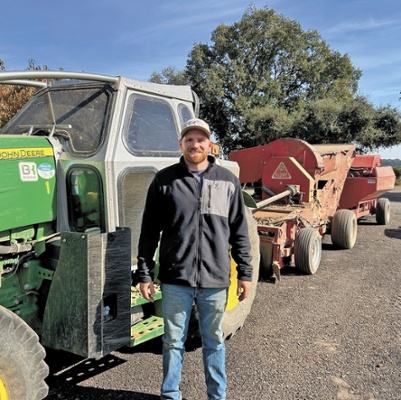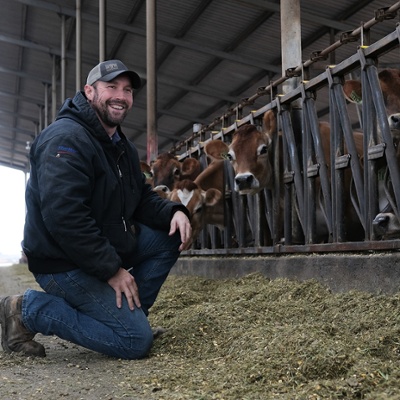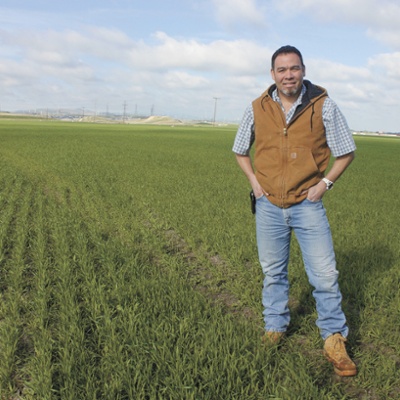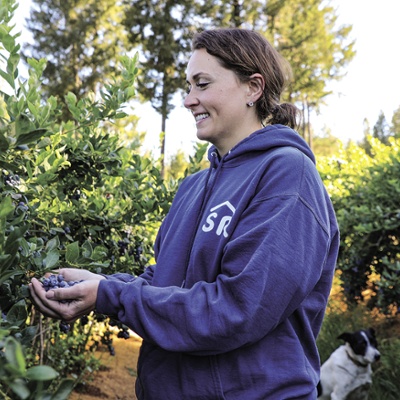-

- July 16, 2025
- From the Fields: Max Francesconi, Sacramento County farmer
-
By Max Francesconi
Sacramento County farmerWe finished planting corn silage, which we supply to dairies, about six weeks to two months ago. It hasn’t tassled out yet. It’s about 4 feet high, and it’s looking good with the spring we had and the early summer.
There were not a ton of cherries, but the quality ended up pretty high with the mild spring and without very much rain. The market was very good, and the price was pretty high. We had a pretty good year, but there were definitely some blocks that weren’t as heavy as years past. We were the exception; we definitely had a lot more cherries than most other growers.
Walnuts look good. This comes back to the mild spring. It looks like it has a pretty good crop on it. Disease pressure has not been horrible.
We have winegrapes, but we do not have any contract, so we are doing our best to keep expenses down. We made minor adjustments to save a bit of money but still keep up the quality. You still have to do your preventative maintenance and keep it growing and keep high-quality grapes on the vine so you could market them towards the end of the year. We definitely applied more sulfur to prevent mildew. Doing this helps us delay our first synthetic spray. Instead of doing a spray at the end of June to now, we added sulfur for a little longer to delay the cost. We’re still spraying but being more economical with it.
We finished harvesting wheat for grain. It’s for rotation, so we can break up the ground and not keep it fallow. Yield was just average, nothing exceptional. The price was not good. Would we have planted it if we knew what the price was towards the end? Who knows. But it’s still good for the ground to have it in there.
In those (wheat) fields, we just finished planting yellow beans. With this weather, we’ll see how the heat comes, but the beans should pop up pretty fast.
-

- July 16, 2025
- From the Fields: Blake Wilbur, Tulare County dairy and tree nut farmer
-
By Blake Wilbur
Tulare County dairy and tree nut farmerOur dairy has 1,600 milking Jersey cows. We’re a Land O’Lakes shipper. A lot of our trucks go to Saputo, and the milk gets made into cheese. We also grow almonds and pistachios and most of our own forage.
Right now, it’s water, water, water. We’re going into the hottest time of the season so far. Nuts are filling and developing. If you lose the opportunity to irrigate intensely, it can affect yields. The almonds look like an average year. Prices are recovering after losing money the last couple years. The pistachio orchards look heavy. I’m hoping for an above-average crop.
We have a groundwater allocation, which limits how much we can pump. When you add it to the surface water we’re getting this year, you can cover most of the crops you would likely grow in the area. At the moment, we’re buying our alfalfa instead of growing it because of its water use and the economics of the hay market.
Feed prices in general have been trending down. It’s the biggest expense on a dairy farm, and it affects our bottom line the most. Milk prices are good enough; we should be making a little money this year. It helps that beef prices are so high. That’s a serious money maker. When cows’ milk has dropped off, they are sold to the beef market. Dairy cattle prices are also high, and we’ve been able to sell excess replacement animals that are often first or second lactation. Prices for those are extremely high.
We caught bird flu last fall and saw milk flow reduce by 25% for two to three weeks. We, fortunately, did not lose many, if any, cows. Dairies with Holsteins suffered worse, and those that got bird flu during the summer heat fared much worse. Our cows have bounced back. Our milk production is actually higher now than it was at this time last year. We had a very nice spring, and coming into summer June was not tough on the cows.
-

- July 16, 2025
- From the Fields: Sean McCauley, Contra Costa County farmer
-
By Sean McCauley
Contra Costa County farmerOur winegrapes and vines look great. All the whites and reds seem to be coming out well. The weather is cooperating. It hasn’t been too hot. For vertical farmers, we’re still value-adding the product. It’s just unfortunate the price is in the tank.
We did not grow any wheat this year because the price is so poor. It’s unbelievable. It’s $120 to $160 a ton, and it costs you $120 to put it in. We’re dry farmers, and in our area, we would lose money. Instead of summer-fallowing half our land, we did all 3,000 acres to let the ground rest this year. We hope the price is going to come back to where we can make some money. Another reason we fallowed is water. You build up that water table in the ground, so you usually have a better crop.
We’re also assessing the olive crop. We’re probably four months away from harvest. Right now, we’re fighting off the olive fruit fly and doing some biological treatments. Our crop doesn’t look very good at all—not because of the fly. Quality is good. It’s just the yield. It’s at least a 25% decrease in tonnage per acre. I don’t know why. I’m trying to figure it out.
The market for our product has been excellent. Extra-virgin olive oil is more popular than ever, and we have built up traction from that. We can sell every bit of oil we have and don’t have to wholesale as much. Brentwood is the U-pick capital of the world, and we take advantage of U-pick season and ag tourism.
With the smaller crop, we’re going to do less wholesale. In this day and age, you have to be agile with your farming entities. When you go vertical with these products, it’s important that as much effort goes into the retail piece as possible. When you have a great crop, you’re able to wholesale more. But when it doesn’t happen for you, then you scale it back and go full retail.
-

- July 16, 2025
- From the Fields: Taylor Serres Murnig, Sonoma and Mendocino counties farmer and rancher
-
By Taylor Serres Murnig
Sonoma and Mendocino counties farmer and rancherIt was a very bountiful blueberry harvest in Mendocino County. We had some of the best quality we’ve seen in the past couple years. The fresh-market blueberry season is pretty short, anywhere from two to three weeks. If we have perfect weather at the beginning of the season, we have a four-week market. This year, the heat hit us. You’re having that dance with Mother Nature, and she is always in the lead. We started harvesting on June 20 and wrapped up last week.
We have been very fortunate with labor. We’ve had the same labor force for the past 15 years, so that has not been an issue. Obviously, the cost of labor is high, and this is the same with other inputs. We are not certified organic, but we do farm organically. We are looking to potentially become certified organic. The price per pound for organic vs. conventional is unbelievable, especially when it comes to the bulk market.
For our winegrapes in Sonoma County, fortunately, we have 95% of the crop sold, so I cannot complain. It could be a lot worse. Everything we do is sold locally in Sonoma and Napa counties. The price is not where we want it to be, but you don’t bite the hand that feeds you. The fact that we have winegrapes sold means we’ll be able to hopefully break even. Yields may be average to a little bit below average. We dropped a lot of fruit to help with overall quality. I expect harvest will not start until the third or fourth week of September, depending on the weather. We have a pretty good niche market with what we do. Plus, we have our wines, including our blueberry wines, available for purchase.
We have an organic cattle operation in Mendocino. Beef is going fantastic. We sold our steers in mid-June, so we have no complaints. I wish I had a herd of 300 cows because it helps pay for everything else.


